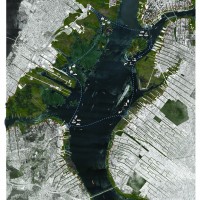Swimming to Manhattan
The “Swimming to Manhattan” competition was created by the Amsterdam Academy for Architecture and ARCAM.
Jacques Abelman, Txell Blanco Diaz, Simona Serafino, Egle Suminskaite, and Marit Janse collaborated to present Red Point Parks, a vision for future development around New York’s Upper Bay, in a future where the sea has risen over 3 meters.
Climate change demands a radical adaptation strategy around the Upper Bay. Our point of departure is water quality. Currently, combined sewage outflows contaminate the bay, and the water level may rise from three to five meters in the future, creating further ecological and infrastructural challenges. Our proposal is the Red Point Park public pier system.
Red Point Parks are a network of access points around the altered urban edge of the renamed Central Bay. Wetlands now occupy the flood zones, creating a living storm buffer. Some buildings have been preserved by stripping their first floors and strengthening the foundations. New piers extend from the access points through eelgrass and fish nursery zones, into deeper waters where oyster reefs have been re-established. Five new transport hubs create a water highway around the bay, giving way to a quieter zone in the center. The restored estuary ecology supports a variety of programs, from scuba diving and windsurfing to new museums and restaurants. In addition there are small artificial beaches at Governor’s Island and the shallows facing Brooklyn. The greenline network connects inner urban areas to the bay and absorbs rain water, diverting it from the sewage system. It is easy to bike or walk along these channels to reach the water’s edge. Channels widen at the end to allow the tides to enter the system.
The aquapuncture of the Red Point Parks responds to climate change to transform the city, creating a new urban edge and a living estuary whose heart is pristine water. In this sense, the entire bay functions as a park.
August 10th, 2100: a summer story
“Do you remember the summer of 2075, when the hurricanes hit? Do you remember how it was before the water got so high?” I asked my friend. We were sitting together on the stoop of our Brooklyn brownstone, it was a sweltering day, 105° F.
“I remember how the sewage used to flow into the water every time it rained. It was a mess when they still called it the Upper Bay. That was a long time ago, and the water is about three meters higher now, and that old waterfront is now the Red Point Parks. Let’s follow the greenlines down there and swim, I can’t take this heat!” she said.
We jumped on our bikes and followed the shallow canal of grasses and trees through Park Slope and down to Red Point Park 33. The old sewage overflow was gone – now at the end of the greenline you could see clean water burbling from the outflow, right before the pier started. Extending through a wetland, the vast new pier stretched out into the bay, alongside old foundations and ancient raised warehouses missing their first floors.
We stripped down to our bathing suits and jumped off the side of the pier where the marshy vegetation gave way to deeper water filled with eelgrass. They say it’s almost clean enough to drink now, and the sturgeons are back.
“Thank god for this luxury that we have at our doorstep. The wetlands even protect us from the hurricanes. Storm buffers you can relax in!” She sighed, floating on her back in the cool water.
“Do you want to go to Governor’s Island Beach this weekend? We can rent an electric boat at the Brooklyn Water Hub. I want to check out diving lessons. Let’s pick our own oysters from the reefs for dinner!” I said, splashing.
We were both enjoying the park, and happy in a city that knew how to adapt to the adversity it faced in the past. Our New York, our Central Bay.






